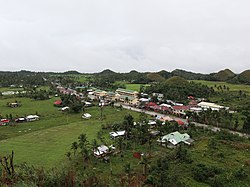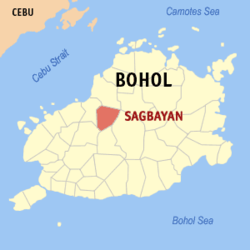Sagbayan, officially the Municipality of Sagbayan (Cebuano: Munisipyo sa Sagbayan; Tagalog: Bayan ng Sagbayan), is a 4th class municipality in the province of Bohol, Philippines. According to the 2020 census, it has a population of 24,335 people.[4]
Sagbayan Borja | |
|---|---|
| Municipality of Sagbayan | |
 San Agustin | |
 Map of Bohol with Sagbayan highlighted | |
Location within the Philippines | |
| Coordinates: 9°55′N 124°06′E / 9.92°N 124.1°E | |
| Country | Philippines |
| Region | Central Visayas |
| Province | Bohol |
| District | 2nd district |
| Founded | February 9, 1949 |
| Renamed | June 21, 1957 |
| Barangays | 24 (see Barangays) |
| Government | |
| • Type | Sangguniang Bayan |
| • Mayor | Restituto Q. Suarez III (suspended)[1] Asuncion B. Ybañez (acting) |
| • Representative | Ma. Vanessa C. Aumentado |
| • Municipal Council | Members |
| • Electorate | 16,758 voters (2022) |
| Area | |
| • Total | 69.61 km2 (26.88 sq mi) |
| Elevation | 424 m (1,391 ft) |
| Highest elevation | 327 m (1,073 ft) |
| Lowest elevation | 47 m (154 ft) |
| Population (2020 census)[4] | |
| • Total | 24,335 |
| • Density | 350/km2 (910/sq mi) |
| • Households | 5,897 |
| Economy | |
| • Income class | 4th municipal income class |
| • Poverty incidence | 25.05 |
| • Revenue | ₱ 113.5 million (2020) |
| • Assets | ₱ 337.3 million (2020) |
| • Expenditure | ₱ 137 million (2020) |
| • Liabilities | ₱ 45.93 million (2020) |
| Service provider | |
| • Electricity | Bohol 1 Electric Cooperative (BOHECO 1) |
| Time zone | UTC+8 (PST) |
| ZIP code | 6331 |
| PSGC | |
| IDD : area code | +63 (0)38 |
| Native languages | Boholano dialect Cebuano Tagalog |
Its main attraction is Sagbayan Peak, a tourism site overlooking a scenic valley with an observation platform and children's playground.[6] While some similar hill formations are visible, it is not within the main Chocolate Hills area.
Sagbayan is 74 kilometres (46 mi) from Tagbilaran.
Sagbayan celebrates its feast on May 4/August 28, to honor the town patron San Agustin.[7]
Etymology
editThe name Sagbayan came from the combination of the local words Sag which means nest, and Bay (short of Balay) which means house. Therefore, Sagbayan means a place for making tree-houses.
Long ago, the place was said to be plentiful of deer and wild pig. People often visit the place to hunt them. They constructed tree houses while waiting for their prey to appear. As time goes, these animals were depopulated, leaving only tree houses left by the hunters.[8]
The proper pronunciation of word Ságbayan has a stress on its first syllable,[8] not Sagbayán, which has stress on its suffix -an, therefore debunking the word Sagbayán which means a place to hang.[9]
History
editSagbayan was formerly part of the surrounding municipalities of Clarin, Inabanga, Carmen, and Balilihan. It was created into a separate town through Executive Order No. 204 of President Elpidio Quirino on February 9, 1949, and named Borja,[10] in honor of Salustiano Borja, the first elected civil governor of the Province of Bohol.[9]
The original list of its barangays and sitios were Sagbayan, Canmaya Centro, Canmaya Diot, Canmano, San Antonio, and San Isidro, and the sitios of Santa Cruz, San Vicente Norte, San Vicente Sur, San Ramon, and Kalangahan (Calangahan), from Clarin; the sitios of Mantalongon and Katipunan from Inabanga, and the sitios of Cabasacan (Kabasacan) and Ubuhan (Ubojan) from Balilihan (note: Catigbian wasstill part of Balilihan until its reorganization on June 17, 1949[11]). Barangay Sagbayan became its Poblacion which is the seat of government of the municipality.
Through the Republic Act No. 1741, it was reverted to its original name, Sagbayan on June 21, 1957, signed by President Carlos P. Garcia.[12]
On October 15, 2013, Sagbayan was close to the epicenter of a magnitude 7.2 earthquake. The town suffered 12 fatalities and damage to almost 1,000 homes, as well as total destruction of its town hall.[13]
Geography
editBarangays
editSagbayan is politically subdivded into 24 barangays. Each barangay consists of puroks and some have sitios.
| PSGC | Barangay | Population | ±% p.a. | |||
|---|---|---|---|---|---|---|
| 2020[4] | 2010[14] | |||||
| 071236001 | Calangahan | 3.9% | 957 | 910 | 0.50% | |
| 071236002 | Canmano | 3.9% | 947 | 1,006 | −0.60% | |
| 071236003 | Canmaya Centro | 6.0% | 1,448 | 1,317 | 0.95% | |
| 071236004 | Canmaya Diot | 5.0% | 1,221 | 1,161 | 0.51% | |
| 071236005 | Dagnawan | 3.5% | 842 | 525 | 4.84% | |
| 071236006 | Kabasacan | 2.2% | 539 | 490 | 0.96% | |
| 071236007 | Kagawasan | 1.5% | 376 | 370 | 0.16% | |
| 071236008 | Katipunan | 2.4% | 591 | 600 | −0.15% | |
| 071236009 | Langtad | 2.2% | 530 | 570 | −0.72% | |
| 071236010 | Libertad Norte | 1.5% | 353 | 316 | 1.11% | |
| 071236011 | Libertad Sur | 0.5% | 117 | 184 | −4.43% | |
| 071236012 | Mantalongon | 3.9% | 952 | 707 | 3.02% | |
| 071236013 | Poblacion | 17.1% | 4,154 | 3,945 | 0.52% | |
| 071236014 | Sagbayan Sur | 4.8% | 1,170 | 1,011 | 1.47% | |
| 071236015 | San Agustin | 4.3% | 1,037 | 867 | 1.81% | |
| 071236016 | San Antonio | 4.0% | 966 | 852 | 1.26% | |
| 071236017 | San Isidro | 3.6% | 882 | 736 | 1.83% | |
| 071236018 | San Ramon | 2.3% | 563 | 405 | 3.35% | |
| 071236019 | San Roque | 1.8% | 434 | 420 | 0.33% | |
| 071236020 | San Vicente Norte | 3.2% | 789 | 715 | 0.99% | |
| 071236021 | San Vicente Sur | 1.2% | 302 | 290 | 0.41% | |
| 071236022 | Santa Catalina | 4.7% | 1,136 | 721 | 4.65% | |
| 071236023 | Santa Cruz | 3.8% | 920 | 985 | −0.68% | |
| 071236024 | Ubojan | 4.6% | 1,113 | 988 | 1.20% | |
| Total | 24,335 | 20,091 | 1.93% | |||
Climate
edit| Climate data for Sagbayan, Bohol | |||||||||||||
|---|---|---|---|---|---|---|---|---|---|---|---|---|---|
| Month | Jan | Feb | Mar | Apr | May | Jun | Jul | Aug | Sep | Oct | Nov | Dec | Year |
| Mean daily maximum °C (°F) | 26 (79) | 27 (81) | 28 (82) | 29 (84) | 30 (86) | 29 (84) | 28 (82) | 29 (84) | 29 (84) | 28 (82) | 27 (81) | 27 (81) | 28 (83) |
| Mean daily minimum °C (°F) | 21 (70) | 21 (70) | 21 (70) | 22 (72) | 23 (73) | 23 (73) | 22 (72) | 22 (72) | 22 (72) | 22 (72) | 22 (72) | 22 (72) | 22 (72) |
| Average precipitation mm (inches) | 98 (3.9) | 82 (3.2) | 96 (3.8) | 71 (2.8) | 104 (4.1) | 129 (5.1) | 101 (4.0) | 94 (3.7) | 99 (3.9) | 135 (5.3) | 174 (6.9) | 143 (5.6) | 1,326 (52.3) |
| Average rainy days | 18.0 | 14.1 | 17.1 | 16.8 | 23.7 | 25.7 | 25.8 | 23.3 | 24.2 | 25.9 | 24.0 | 20.6 | 259.2 |
| Source: Meteoblue [15] | |||||||||||||
Demographics
edit| Year | Pop. | ±% p.a. |
|---|---|---|
| 1960 | 8,720 | — |
| 1970 | 10,822 | +2.18% |
| 1975 | 12,500 | +2.93% |
| 1980 | 12,703 | +0.32% |
| 1990 | 15,364 | +1.92% |
| 1995 | 16,488 | +1.33% |
| 2000 | 18,346 | +2.32% |
| 2007 | 19,399 | +0.77% |
| 2010 | 20,091 | +1.28% |
| 2015 | 22,339 | +2.04% |
| 2020 | 24,335 | +1.70% |
| Source: Philippine Statistics Authority[16][14][17][18] | ||
Economy
editPoverty incidence of Sagbayan
10 20 30 40 50 60 2006 57.10 2009 48.78 2012 24.01 2015 23.90 2018 21.50 2021 25.05 Source: Philippine Statistics Authority[19][20][21][22][23][24][25][26] |
Gallery
edit- Municipal Building (totally destroyed in the 2013 earthquake)
- Sagbayan Peak
- View of the Chocolate Hills from Sagbayan Peak






